第十二章 句子的种类 课件(共37张PPT) 2024年中考英语二轮专题复习(广东专版)
文档属性
| 名称 | 第十二章 句子的种类 课件(共37张PPT) 2024年中考英语二轮专题复习(广东专版) | 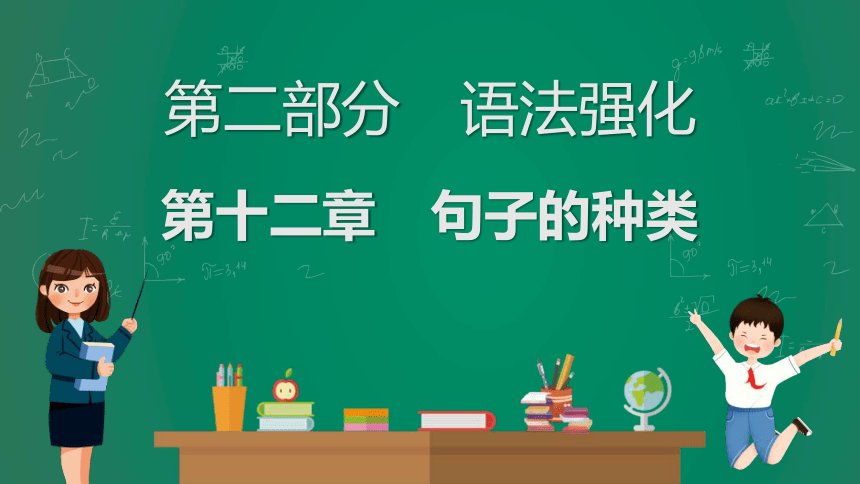 | |
| 格式 | pptx | ||
| 文件大小 | 2.9MB | ||
| 资源类型 | 教案 | ||
| 版本资源 | 通用版 | ||
| 科目 | 英语 | ||
| 更新时间 | 2024-06-02 17:47:20 | ||
图片预览


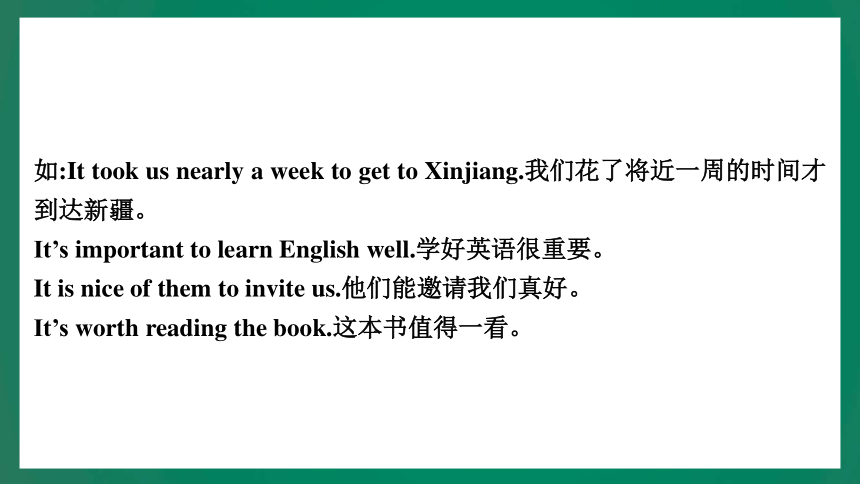
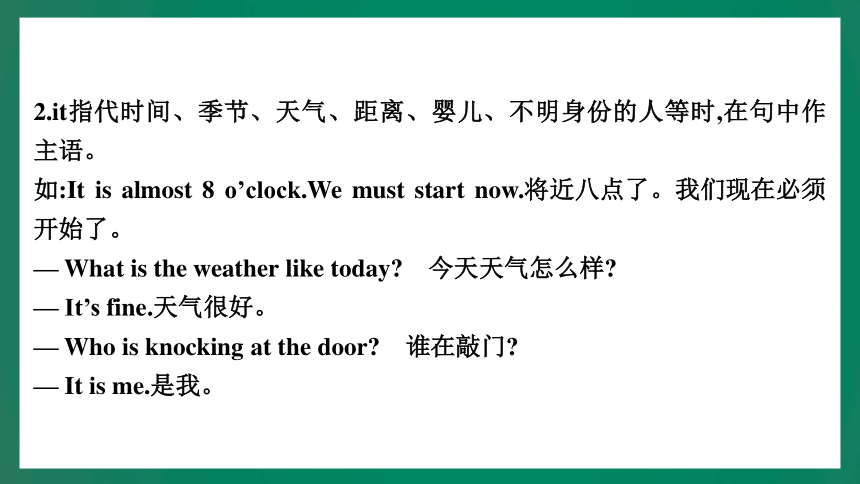
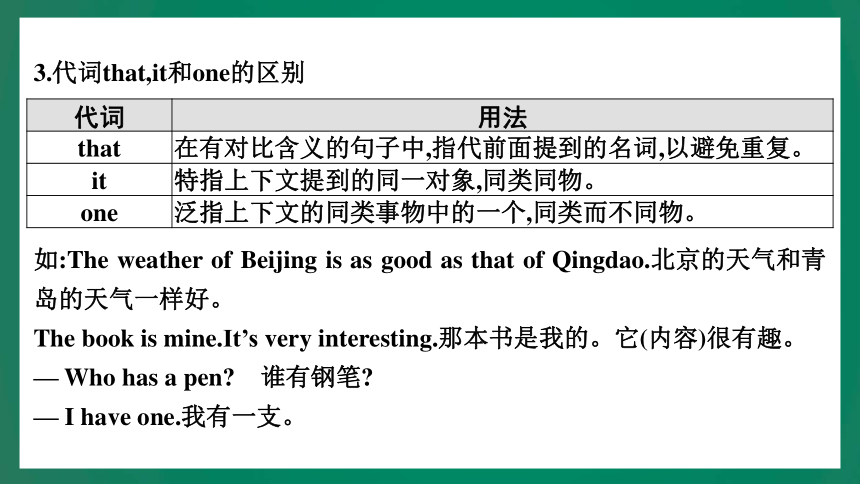
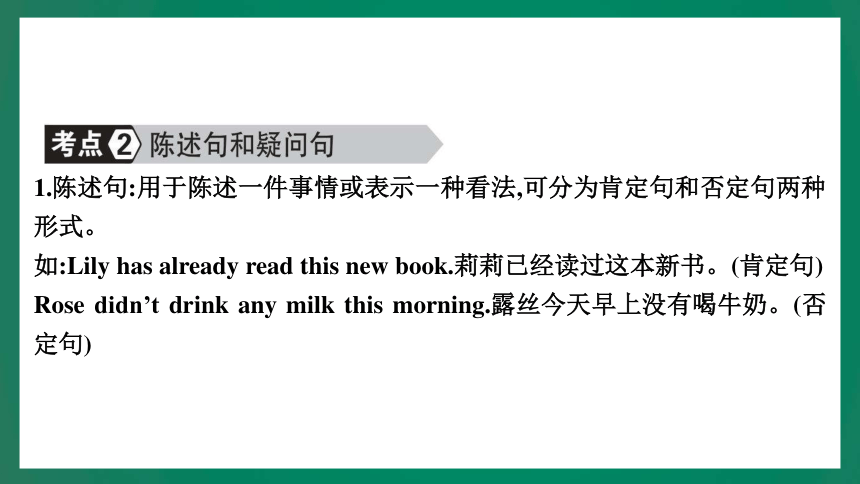
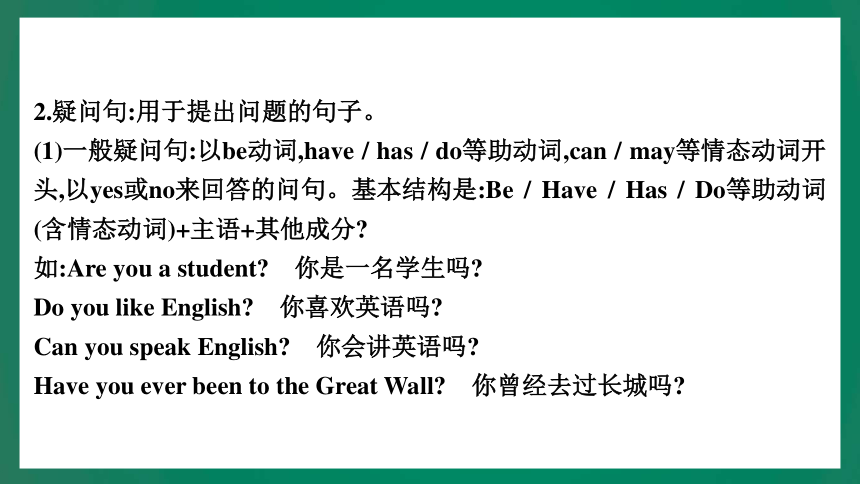
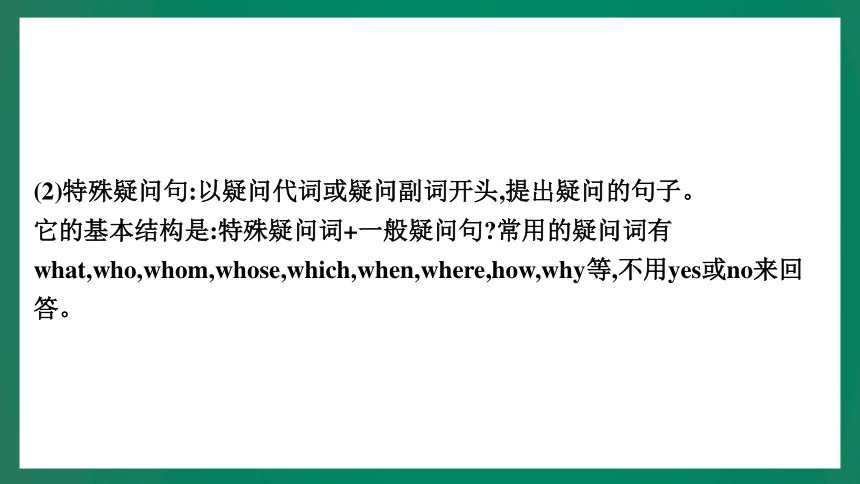

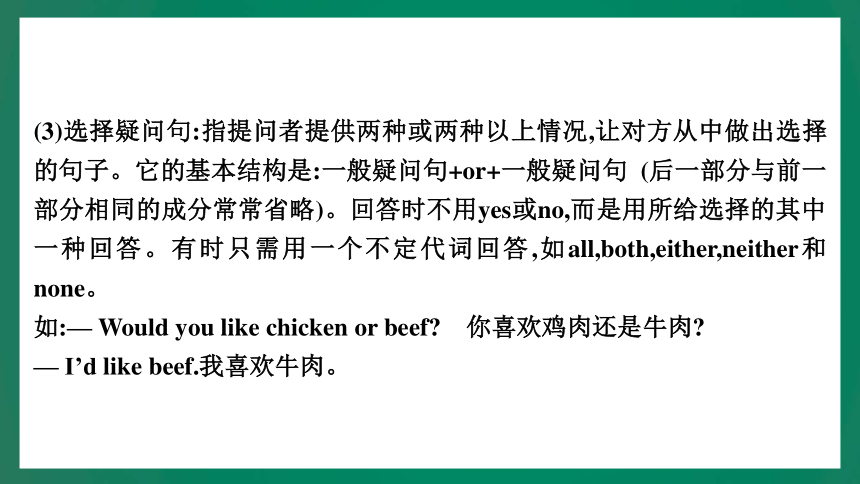
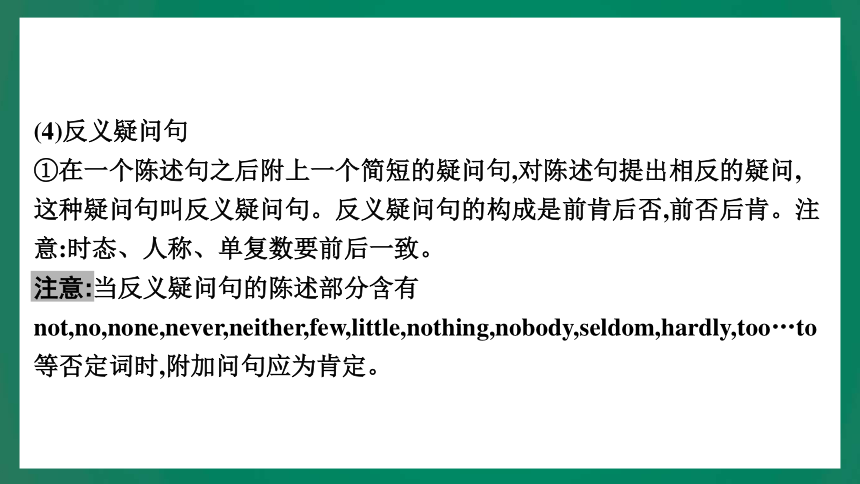
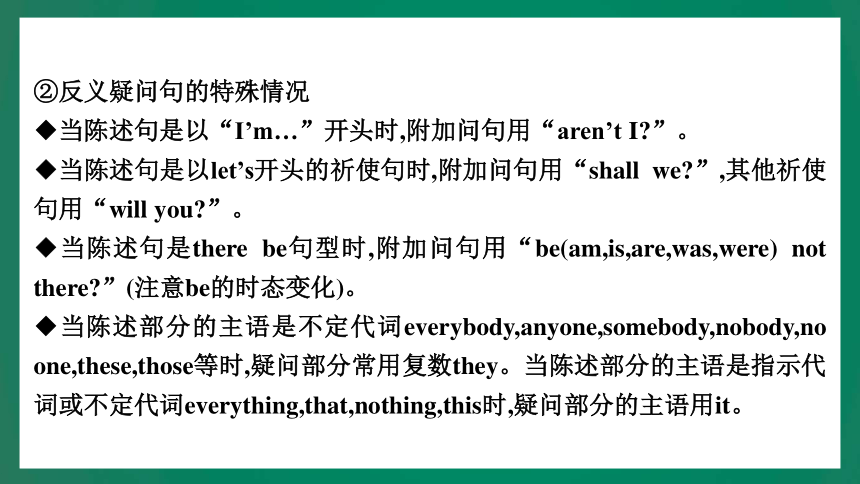
文档简介
(共37张PPT)
第二部分 语法强化
第十二章 句子的种类
1.it作形式主语的常用句型
It takes sb. some time to do sth.做某事花了某人多少时间
It’s+adj.+to do sth.做某事是怎样的
It’s+adj.+for / of sb.to do sth.做某事对某人而言是怎样的 / 做某事某人是怎样的
It’s no use / no good / worth doing sth.做某事没用处 / 没好处 / 值得做某事
如:It took us nearly a week to get to Xinjiang.我们花了将近一周的时间才到达新疆。
It’s important to learn English well.学好英语很重要。
It is nice of them to invite us.他们能邀请我们真好。
It’s worth reading the book.这本书值得一看。
2.it指代时间、季节、天气、距离、婴儿、不明身份的人等时,在句中作主语。
如:It is almost 8 o’clock.We must start now.将近八点了。我们现在必须开始了。
— What is the weather like today 今天天气怎么样
— It’s fine.天气很好。
— Who is knocking at the door 谁在敲门
— It is me.是我。
3.代词that,it和one的区别
代词 用法
that 在有对比含义的句子中,指代前面提到的名词,以避免重复。
it 特指上下文提到的同一对象,同类同物。
one 泛指上下文的同类事物中的一个,同类而不同物。
如:The weather of Beijing is as good as that of Qingdao.北京的天气和青岛的天气一样好。
The book is mine.It’s very interesting.那本书是我的。它(内容)很有趣。
— Who has a pen 谁有钢笔
— I have one.我有一支。
1.陈述句:用于陈述一件事情或表示一种看法,可分为肯定句和否定句两种形式。
如:Lily has already read this new book.莉莉已经读过这本新书。(肯定句)
Rose didn’t drink any milk this morning.露丝今天早上没有喝牛奶。(否定句)
2.疑问句:用于提出问题的句子。
(1)一般疑问句:以be动词,have / has / do等助动词,can / may等情态动词开头,以yes或no来回答的问句。基本结构是:Be / Have / Has / Do等助动词 (含情态动词)+主语+其他成分
如:Are you a student 你是一名学生吗
Do you like English 你喜欢英语吗
Can you speak English 你会讲英语吗
Have you ever been to the Great Wall 你曾经去过长城吗
(2)特殊疑问句:以疑问代词或疑问副词开头,提出疑问的句子。
它的基本结构是:特殊疑问词+一般疑问句 常用的疑问词有what,who,whom,whose,which,when,where,how,why等,不用yes或no来回答。
如:Which pen do you like 你喜欢哪支钢笔
Who are you 你是谁
①对数量提问,疑问词用how many / how much,注意疑问词how many必须接复数名词。
②对价格提问,疑问词用how much。
③对时间长度提问,疑问词用how long。
④对如 once a year,twice a week等时间频率提问,疑问词用how often。
⑤对如 once,twice,three times等具体次数提问,疑问词用how many times。
⑥对“in+一段时间”提问,疑问词一般用how soon(用于将来时态)。
⑦对距离提问,疑问词用how far。
(3)选择疑问句:指提问者提供两种或两种以上情况,让对方从中做出选择的句子。它的基本结构是:一般疑问句+or+一般疑问句 (后一部分与前一部分相同的成分常常省略)。回答时不用yes或no,而是用所给选择的其中一种回答。有时只需用一个不定代词回答,如all,both,either,neither和 none。
如:— Would you like chicken or beef 你喜欢鸡肉还是牛肉
— I’d like beef.我喜欢牛肉。
(4)反义疑问句
①在一个陈述句之后附上一个简短的疑问句,对陈述句提出相反的疑问,这种疑问句叫反义疑问句。反义疑问句的构成是前肯后否,前否后肯。注意:时态、人称、单复数要前后一致。
注意:当反义疑问句的陈述部分含有not,no,none,never,neither,few,little,nothing,nobody,seldom,hardly,too…to 等否定词时,附加问句应为肯定。
②反义疑问句的特殊情况
◆当陈述句是以“I’m…”开头时,附加问句用“aren’t I ”。
◆当陈述句是以let’s开头的祈使句时,附加问句用“shall we ”,其他祈使句用“will you ”。
◆当陈述句是there be句型时,附加问句用“be(am,is,are,was,were) not there ”(注意be的时态变化)。
◆当陈述部分的主语是不定代词everybody,anyone,somebody,nobody,no one,these,those等时,疑问部分常用复数they。当陈述部分的主语是指示代词或不定代词everything,that,nothing,this时,疑问部分的主语用it。
◆当陈述句是由I / we (don’t / didn’t) think / suppose / believe等开头时,反义疑问句应和有关宾语从句的人称、时态保持一致,并根据主句选用肯定或否定形式。
◆当陈述句中的must表示“必须”时,疑问句用needn’t / mustn’t。陈述句中的mustn’t表示“禁止”时,疑问句用must。陈述句中的must表示“一定”时,疑问句部分应用must后面的动词相对应的助动词形式。
◆当陈述部分有“had better+动词原形”时,疑问部分用“hadn’t you ”。
◆当陈述部分有“have / has / had to+动词原形”,疑问部分常用“don’t / doesn’t / didn’t+主语”。
③注意回答反义疑问句时英语表达习惯的不同。
如:— Li Lei never goes to school late,does he 李雷上学从不迟到,是吗
— Yes,he does.不,他迟到。/ No,he doesn’t.是的,他从不迟到。
④反义疑问句中要注意有些词的缩略形式。
‘s既是has也是is的缩略形式。 ‘d既是would也是had的缩略形式。
如:He’s already finished his homework,hasn’t he 他已经完成了他的作业,是吗
He’s often told to come here,isn’t he 他经常被告知要来这里,是吗
You’d better complete it by yourself,hadn’t you 你最好自己完成它,可以吗
即学即练
一、单项选择。
( )1.(2022·连云港市中考真题)We learned to work as a team by completing the task.
A.what B.which C.how D.who
( )2.(2022·黑龙江省中考)— Mum,let’s order some food online
for dinner,
— Good idea.I’d like some beef dumplings.
A.will you B.won’t you C.shall we D.don’t you
C
C
( )3.(2020·黔西南州中考)Jack,you’re going to the mountain village to help the children,
A.don’t you B.do you C.aren’t you D.are you
( )4. rained heavily yesterday.I had to stay at home.
A.It B.That C.It’s D.This
( )5.It is no use with people who lose their heads.
A.to argue B.arguing C.argue D.argued
( )6. is easy for us this task.
A.It;to complete B.It;completing C.Its;to complete D.Its;completing
A
B
A
C
( )7.When Patty makes a promise,she keeps .
A.it B.them C.its D.ones
( )8. seemed that she was really nervous.
A.That B.This C.It’s D.It
( )9.(2020·遂宁市中考)Tom hardly eats breakfast,
A.isn’t he B.is he C.doesn’t he D.does he
( )10.He learned that took Tom about three hours a day the job and he could get twenty dollars each week.
A.it;to do B.its;doing C.this;to do D.that;doing
A
D
D
A
二、用适当的疑问词填空。
1.(2022·扬州市中考改编)— Tell me,Grandma. is your favourite person in the whole wide world
— That’s easy! It’s you!
2.(2022·乐山市中考改编)— is your home from school
— About a 15-minute walk.
How far
Who
3.(2020·黔南州中考改编)— Mike, will the new science museum be built
— It will be built in the centre of the city.
4.(2021年扬州市中考改编)— do you play basketball with your friends
— Only once a week.
5.(2021年南通市中考改编) — does May look like
— She is a pretty girl with big bright eyes and long straight hair.
What
How often
where
三、用or或and填空或按要求改写句子。
1.Are they sitting standing in the classroom
2.The students stopped talking laughing when the teacher came in.
3.Meimei likes boating.(用swim改成选择疑问句)
Meimei boating swimming
4.She is a doctor.(用a nurse 改成选择疑问句)
a doctor a nurse
or
Is she
or
like
Does
and
or
用来表达喜、怒、哀、乐等强烈感情的句子叫作感叹句,句末用感叹号。感叹句一般用感叹词how或what引导,how修饰形容词或副词,what修饰名词。
1.how引导的感叹句,基本结构是:How+形容词 / 副词+主语+谓语!(主谓可省略)
如:How beautiful the park is! 这个公园多美丽呀!
2.what引导的感叹句,基本结构是:
(1)What+a / an+形容词+可数名词 (单数)+主语+谓语!(主谓可省略)
如:What a nice girl (she is)! (她是)多么友善的一个女孩!
(2)What+形容词+可数名词复数 / 或不可数名词+主语+谓语!
如:What beautiful flowers these are! 这些是多么美丽的花!
What fine weather it is! 天气多好啊!
注意: what后接不可数名词时,名词前面不能加不定冠词a或an。
如:What good news it is! 这是多好的消息啊!
Look! What fine weather it is today! 看!今天天气多好啊!
类似的还有:What bad weather! 多糟糕的天气啊!
What hard work! 多困难的工作啊!
What delicious food! 多美味的食物啊!
即学即练
用what,what a / an或how 填空。
1.(2023·凉山彝族自治州中考改编)— clean the classroom is!
— So it is.The students clean it every day.
2.(2022·达州市中考改编)— Gu Ailing achieved her dream and won two gold medals in Beijing 2022 Winter Olympics.
— excellent girl!
3.(2022·昆明市中考改编)— Shenzhou XIV carried three Chinese astronauts into space successfully.
— Wow, exciting news! We are so proud.
what
What an
How
4.(2022·重庆市中考改编) fresh spring morning it is!
5.(2022·株洲市中考改编) lovely Bing Dwendwen is! Everyone wants to have one.
6.(2022·玉林市中考改编)— China is becoming stronger and stronger.More and more foreign people are learning Chinese.
— proud we are! We don’t regret being Chinese.
7.(2022·梧州市中考改编)— We picked apples on the farm and had fun yesterday.
— wonderful day it was!
What a
How
How
What a
8.(2022·滨州市中考改编)— exciting speech our headmaster gave just now!
— Yeah,it was really an inspiration to us all.
9.(2022·铜仁市中考改编)— Maria,we will graduate in a week.
— time flies! We should keep in touch.
10.(2022·盘锦市中考改编)Listen! My grandpa is playing erhu.
beautiful music it is!
11.(2022·营口市中考改编)Listen! wonderful news report Betty is giving! Everyone likes it very much.
What a
What
How
What an
12.(2022·朝阳市中考改编) fast technology has progressed over the years!
13.(2022·贵港市中考改编)— wonderful the opening of the Beijing Winter Olympics is!
— So it is.
14.(2022·绥化市中考改编)— I went to the charity (慈善机构) as a volunteer last Saturday.
— Good job! valuable the experience was!
15.(2022·黑龙江省中考改编)— It has been rainy for a week.
— terrible weather it is!
What
How
How
How
表示请求、命令、建议或劝告等的句子叫祈使句,主语you通常省略。
1.祈使句的肯定形式:一般以动词原形开头。
如:Do your homework after school.放学后做家庭作业。
Let’s go and have a look.让我们去看看。
Let me have a try.让我试试吧。
Be happy,my friend.高兴点,朋友。
2.祈使句的否定形式:在句首谓语动词前加Don’t。
如:Don’t let me work with him.=Let me not work with him.别让我跟他一起工作。
Don’t spend much time on computer games.=You mustn’t spend much time on computer games.
别在电脑游戏上花费太多时间。
Don’t be late again.别再迟到。
3.在公共场合的提示语中,祈使句的否定句常用“No+名词或动名词”表示“禁止做某事”。
如:No photos! 禁止拍照。
No smoking here!=Smoking is not allowed here! 严禁在此抽烟!
注意: (1)“祈使句+and / or+简单句”是常用句型。
如:Be quick,or you’ll be late.=If you are not quick,you’ll be late.
快点,不然你会迟到的。
(2)表示否定意义的祈使句=mustn’t。
如:Don’t draw on the wall.=You mustn’t draw on the wall.不要在墙上画画。
1.倒装句的分类及用法
分类 倒装条件 例句
完全倒装 here,there,up,down,in,out,off,away等副词开头的句子表示强调 Out rushed the children.孩子们跑出去了。
表示地点的介词短语作状语位于句首 Under the tree stood two tables and four chairs.树下有两张餐桌和四张椅子。
强调表语,置于句首,或为保持句子平衡 Present at the meeting were 1,000 students.
有1,000名学生出席了会议。
分类 倒装条件 例句
never,hardly,scarcely,seldom, little,not until,not等表示否定意义的副词放于句首 Hardly did I know what had happened.
我几乎不知道发生了什么事。
only和修饰的状语放于句首 Only then did he realize the importance of English.直到那时,他才意识到英语的重要性。
“not only…but also…”连接并列的句子,“前倒后不倒” Not only does he know French,but also he is expert at it.他不但懂法语,而且精通法语。
“neither…nor…”连接并列的句子,前后都倒装 Neither do I know it,nor do I care about it.
我不知道这件事,也不在乎它。
部 分 倒 装
(续表)
分类 倒装条件 例句
so…that,such…that中的so或such及修饰的成分放于句首时“前倒后不倒” So busy is he that he cannot go on a holiday.他是如此的忙,以至于不能去度假。
as引导的让步状语 Child as he is,he has learned a lot.
作为一个小孩,他学到了很多。
so,neither或nor表示前文内容,也适用于另外的人或事 He can play the piano.So can I.
他会弹钢琴。我也会。
用于表示祝愿的祈使句中 May you be in good health!愿你身体健康!
省略if的虚拟条件 Were I you,I would not do it in this way.
如果我是你,我不会这样做。
部 分 倒 装
(续表)
2.倒装句的结构
(1)如果前面的句子是肯定句,那么倒装句的结构有:
①“So+助动词 / be动词 / 情态动词+主语”,表示“某人 / 某物也是这样”。
② “So+主语+助动词 / be动词 / 情态动词”,表示“某人 / 某物确实这样”。
如:Xiao Ming is a good student.So is Sam.小明是个好学生。山姆也是。
Xiao Ming is a good student.So he is.小明是个好学生。他确实如此。
(2)如果前面的句子是否定句,那么倒装句结构为:
“Neither / Nor+助动词 / be动词 / 情态动词+主语”,表示“某人 / 某物也不这样”。
如:Mike is not good at swimming.Neither / Nor is Sam.迈克不擅长游泳。山姆也是。
3.以here,there 等开头的句子,如果主语是名词,就用倒装句,如果主语是人称代词就无须使用倒装句。
如:Here are some flowers for you.这些花送给你。
Here you are.给你。
即学即练
根据汉语意思完成句子。
1.He will go to Hainan for a visit.So (我也会去).
2.He will go to Hainan for a visit.So (他的确如此).
3.Tom was late for class yesterday.So (他的确如此).
4.My mother can speak English. (我也会).
5.My mother can’t speak English. (我也不会).
Neither / Nor can I
So can I
he was
he will
will I
谢 谢 观 看
第二部分 语法强化
第十二章 句子的种类
1.it作形式主语的常用句型
It takes sb. some time to do sth.做某事花了某人多少时间
It’s+adj.+to do sth.做某事是怎样的
It’s+adj.+for / of sb.to do sth.做某事对某人而言是怎样的 / 做某事某人是怎样的
It’s no use / no good / worth doing sth.做某事没用处 / 没好处 / 值得做某事
如:It took us nearly a week to get to Xinjiang.我们花了将近一周的时间才到达新疆。
It’s important to learn English well.学好英语很重要。
It is nice of them to invite us.他们能邀请我们真好。
It’s worth reading the book.这本书值得一看。
2.it指代时间、季节、天气、距离、婴儿、不明身份的人等时,在句中作主语。
如:It is almost 8 o’clock.We must start now.将近八点了。我们现在必须开始了。
— What is the weather like today 今天天气怎么样
— It’s fine.天气很好。
— Who is knocking at the door 谁在敲门
— It is me.是我。
3.代词that,it和one的区别
代词 用法
that 在有对比含义的句子中,指代前面提到的名词,以避免重复。
it 特指上下文提到的同一对象,同类同物。
one 泛指上下文的同类事物中的一个,同类而不同物。
如:The weather of Beijing is as good as that of Qingdao.北京的天气和青岛的天气一样好。
The book is mine.It’s very interesting.那本书是我的。它(内容)很有趣。
— Who has a pen 谁有钢笔
— I have one.我有一支。
1.陈述句:用于陈述一件事情或表示一种看法,可分为肯定句和否定句两种形式。
如:Lily has already read this new book.莉莉已经读过这本新书。(肯定句)
Rose didn’t drink any milk this morning.露丝今天早上没有喝牛奶。(否定句)
2.疑问句:用于提出问题的句子。
(1)一般疑问句:以be动词,have / has / do等助动词,can / may等情态动词开头,以yes或no来回答的问句。基本结构是:Be / Have / Has / Do等助动词 (含情态动词)+主语+其他成分
如:Are you a student 你是一名学生吗
Do you like English 你喜欢英语吗
Can you speak English 你会讲英语吗
Have you ever been to the Great Wall 你曾经去过长城吗
(2)特殊疑问句:以疑问代词或疑问副词开头,提出疑问的句子。
它的基本结构是:特殊疑问词+一般疑问句 常用的疑问词有what,who,whom,whose,which,when,where,how,why等,不用yes或no来回答。
如:Which pen do you like 你喜欢哪支钢笔
Who are you 你是谁
①对数量提问,疑问词用how many / how much,注意疑问词how many必须接复数名词。
②对价格提问,疑问词用how much。
③对时间长度提问,疑问词用how long。
④对如 once a year,twice a week等时间频率提问,疑问词用how often。
⑤对如 once,twice,three times等具体次数提问,疑问词用how many times。
⑥对“in+一段时间”提问,疑问词一般用how soon(用于将来时态)。
⑦对距离提问,疑问词用how far。
(3)选择疑问句:指提问者提供两种或两种以上情况,让对方从中做出选择的句子。它的基本结构是:一般疑问句+or+一般疑问句 (后一部分与前一部分相同的成分常常省略)。回答时不用yes或no,而是用所给选择的其中一种回答。有时只需用一个不定代词回答,如all,both,either,neither和 none。
如:— Would you like chicken or beef 你喜欢鸡肉还是牛肉
— I’d like beef.我喜欢牛肉。
(4)反义疑问句
①在一个陈述句之后附上一个简短的疑问句,对陈述句提出相反的疑问,这种疑问句叫反义疑问句。反义疑问句的构成是前肯后否,前否后肯。注意:时态、人称、单复数要前后一致。
注意:当反义疑问句的陈述部分含有not,no,none,never,neither,few,little,nothing,nobody,seldom,hardly,too…to 等否定词时,附加问句应为肯定。
②反义疑问句的特殊情况
◆当陈述句是以“I’m…”开头时,附加问句用“aren’t I ”。
◆当陈述句是以let’s开头的祈使句时,附加问句用“shall we ”,其他祈使句用“will you ”。
◆当陈述句是there be句型时,附加问句用“be(am,is,are,was,were) not there ”(注意be的时态变化)。
◆当陈述部分的主语是不定代词everybody,anyone,somebody,nobody,no one,these,those等时,疑问部分常用复数they。当陈述部分的主语是指示代词或不定代词everything,that,nothing,this时,疑问部分的主语用it。
◆当陈述句是由I / we (don’t / didn’t) think / suppose / believe等开头时,反义疑问句应和有关宾语从句的人称、时态保持一致,并根据主句选用肯定或否定形式。
◆当陈述句中的must表示“必须”时,疑问句用needn’t / mustn’t。陈述句中的mustn’t表示“禁止”时,疑问句用must。陈述句中的must表示“一定”时,疑问句部分应用must后面的动词相对应的助动词形式。
◆当陈述部分有“had better+动词原形”时,疑问部分用“hadn’t you ”。
◆当陈述部分有“have / has / had to+动词原形”,疑问部分常用“don’t / doesn’t / didn’t+主语”。
③注意回答反义疑问句时英语表达习惯的不同。
如:— Li Lei never goes to school late,does he 李雷上学从不迟到,是吗
— Yes,he does.不,他迟到。/ No,he doesn’t.是的,他从不迟到。
④反义疑问句中要注意有些词的缩略形式。
‘s既是has也是is的缩略形式。 ‘d既是would也是had的缩略形式。
如:He’s already finished his homework,hasn’t he 他已经完成了他的作业,是吗
He’s often told to come here,isn’t he 他经常被告知要来这里,是吗
You’d better complete it by yourself,hadn’t you 你最好自己完成它,可以吗
即学即练
一、单项选择。
( )1.(2022·连云港市中考真题)We learned to work as a team by completing the task.
A.what B.which C.how D.who
( )2.(2022·黑龙江省中考)— Mum,let’s order some food online
for dinner,
— Good idea.I’d like some beef dumplings.
A.will you B.won’t you C.shall we D.don’t you
C
C
( )3.(2020·黔西南州中考)Jack,you’re going to the mountain village to help the children,
A.don’t you B.do you C.aren’t you D.are you
( )4. rained heavily yesterday.I had to stay at home.
A.It B.That C.It’s D.This
( )5.It is no use with people who lose their heads.
A.to argue B.arguing C.argue D.argued
( )6. is easy for us this task.
A.It;to complete B.It;completing C.Its;to complete D.Its;completing
A
B
A
C
( )7.When Patty makes a promise,she keeps .
A.it B.them C.its D.ones
( )8. seemed that she was really nervous.
A.That B.This C.It’s D.It
( )9.(2020·遂宁市中考)Tom hardly eats breakfast,
A.isn’t he B.is he C.doesn’t he D.does he
( )10.He learned that took Tom about three hours a day the job and he could get twenty dollars each week.
A.it;to do B.its;doing C.this;to do D.that;doing
A
D
D
A
二、用适当的疑问词填空。
1.(2022·扬州市中考改编)— Tell me,Grandma. is your favourite person in the whole wide world
— That’s easy! It’s you!
2.(2022·乐山市中考改编)— is your home from school
— About a 15-minute walk.
How far
Who
3.(2020·黔南州中考改编)— Mike, will the new science museum be built
— It will be built in the centre of the city.
4.(2021年扬州市中考改编)— do you play basketball with your friends
— Only once a week.
5.(2021年南通市中考改编) — does May look like
— She is a pretty girl with big bright eyes and long straight hair.
What
How often
where
三、用or或and填空或按要求改写句子。
1.Are they sitting standing in the classroom
2.The students stopped talking laughing when the teacher came in.
3.Meimei likes boating.(用swim改成选择疑问句)
Meimei boating swimming
4.She is a doctor.(用a nurse 改成选择疑问句)
a doctor a nurse
or
Is she
or
like
Does
and
or
用来表达喜、怒、哀、乐等强烈感情的句子叫作感叹句,句末用感叹号。感叹句一般用感叹词how或what引导,how修饰形容词或副词,what修饰名词。
1.how引导的感叹句,基本结构是:How+形容词 / 副词+主语+谓语!(主谓可省略)
如:How beautiful the park is! 这个公园多美丽呀!
2.what引导的感叹句,基本结构是:
(1)What+a / an+形容词+可数名词 (单数)+主语+谓语!(主谓可省略)
如:What a nice girl (she is)! (她是)多么友善的一个女孩!
(2)What+形容词+可数名词复数 / 或不可数名词+主语+谓语!
如:What beautiful flowers these are! 这些是多么美丽的花!
What fine weather it is! 天气多好啊!
注意: what后接不可数名词时,名词前面不能加不定冠词a或an。
如:What good news it is! 这是多好的消息啊!
Look! What fine weather it is today! 看!今天天气多好啊!
类似的还有:What bad weather! 多糟糕的天气啊!
What hard work! 多困难的工作啊!
What delicious food! 多美味的食物啊!
即学即练
用what,what a / an或how 填空。
1.(2023·凉山彝族自治州中考改编)— clean the classroom is!
— So it is.The students clean it every day.
2.(2022·达州市中考改编)— Gu Ailing achieved her dream and won two gold medals in Beijing 2022 Winter Olympics.
— excellent girl!
3.(2022·昆明市中考改编)— Shenzhou XIV carried three Chinese astronauts into space successfully.
— Wow, exciting news! We are so proud.
what
What an
How
4.(2022·重庆市中考改编) fresh spring morning it is!
5.(2022·株洲市中考改编) lovely Bing Dwendwen is! Everyone wants to have one.
6.(2022·玉林市中考改编)— China is becoming stronger and stronger.More and more foreign people are learning Chinese.
— proud we are! We don’t regret being Chinese.
7.(2022·梧州市中考改编)— We picked apples on the farm and had fun yesterday.
— wonderful day it was!
What a
How
How
What a
8.(2022·滨州市中考改编)— exciting speech our headmaster gave just now!
— Yeah,it was really an inspiration to us all.
9.(2022·铜仁市中考改编)— Maria,we will graduate in a week.
— time flies! We should keep in touch.
10.(2022·盘锦市中考改编)Listen! My grandpa is playing erhu.
beautiful music it is!
11.(2022·营口市中考改编)Listen! wonderful news report Betty is giving! Everyone likes it very much.
What a
What
How
What an
12.(2022·朝阳市中考改编) fast technology has progressed over the years!
13.(2022·贵港市中考改编)— wonderful the opening of the Beijing Winter Olympics is!
— So it is.
14.(2022·绥化市中考改编)— I went to the charity (慈善机构) as a volunteer last Saturday.
— Good job! valuable the experience was!
15.(2022·黑龙江省中考改编)— It has been rainy for a week.
— terrible weather it is!
What
How
How
How
表示请求、命令、建议或劝告等的句子叫祈使句,主语you通常省略。
1.祈使句的肯定形式:一般以动词原形开头。
如:Do your homework after school.放学后做家庭作业。
Let’s go and have a look.让我们去看看。
Let me have a try.让我试试吧。
Be happy,my friend.高兴点,朋友。
2.祈使句的否定形式:在句首谓语动词前加Don’t。
如:Don’t let me work with him.=Let me not work with him.别让我跟他一起工作。
Don’t spend much time on computer games.=You mustn’t spend much time on computer games.
别在电脑游戏上花费太多时间。
Don’t be late again.别再迟到。
3.在公共场合的提示语中,祈使句的否定句常用“No+名词或动名词”表示“禁止做某事”。
如:No photos! 禁止拍照。
No smoking here!=Smoking is not allowed here! 严禁在此抽烟!
注意: (1)“祈使句+and / or+简单句”是常用句型。
如:Be quick,or you’ll be late.=If you are not quick,you’ll be late.
快点,不然你会迟到的。
(2)表示否定意义的祈使句=mustn’t。
如:Don’t draw on the wall.=You mustn’t draw on the wall.不要在墙上画画。
1.倒装句的分类及用法
分类 倒装条件 例句
完全倒装 here,there,up,down,in,out,off,away等副词开头的句子表示强调 Out rushed the children.孩子们跑出去了。
表示地点的介词短语作状语位于句首 Under the tree stood two tables and four chairs.树下有两张餐桌和四张椅子。
强调表语,置于句首,或为保持句子平衡 Present at the meeting were 1,000 students.
有1,000名学生出席了会议。
分类 倒装条件 例句
never,hardly,scarcely,seldom, little,not until,not等表示否定意义的副词放于句首 Hardly did I know what had happened.
我几乎不知道发生了什么事。
only和修饰的状语放于句首 Only then did he realize the importance of English.直到那时,他才意识到英语的重要性。
“not only…but also…”连接并列的句子,“前倒后不倒” Not only does he know French,but also he is expert at it.他不但懂法语,而且精通法语。
“neither…nor…”连接并列的句子,前后都倒装 Neither do I know it,nor do I care about it.
我不知道这件事,也不在乎它。
部 分 倒 装
(续表)
分类 倒装条件 例句
so…that,such…that中的so或such及修饰的成分放于句首时“前倒后不倒” So busy is he that he cannot go on a holiday.他是如此的忙,以至于不能去度假。
as引导的让步状语 Child as he is,he has learned a lot.
作为一个小孩,他学到了很多。
so,neither或nor表示前文内容,也适用于另外的人或事 He can play the piano.So can I.
他会弹钢琴。我也会。
用于表示祝愿的祈使句中 May you be in good health!愿你身体健康!
省略if的虚拟条件 Were I you,I would not do it in this way.
如果我是你,我不会这样做。
部 分 倒 装
(续表)
2.倒装句的结构
(1)如果前面的句子是肯定句,那么倒装句的结构有:
①“So+助动词 / be动词 / 情态动词+主语”,表示“某人 / 某物也是这样”。
② “So+主语+助动词 / be动词 / 情态动词”,表示“某人 / 某物确实这样”。
如:Xiao Ming is a good student.So is Sam.小明是个好学生。山姆也是。
Xiao Ming is a good student.So he is.小明是个好学生。他确实如此。
(2)如果前面的句子是否定句,那么倒装句结构为:
“Neither / Nor+助动词 / be动词 / 情态动词+主语”,表示“某人 / 某物也不这样”。
如:Mike is not good at swimming.Neither / Nor is Sam.迈克不擅长游泳。山姆也是。
3.以here,there 等开头的句子,如果主语是名词,就用倒装句,如果主语是人称代词就无须使用倒装句。
如:Here are some flowers for you.这些花送给你。
Here you are.给你。
即学即练
根据汉语意思完成句子。
1.He will go to Hainan for a visit.So (我也会去).
2.He will go to Hainan for a visit.So (他的确如此).
3.Tom was late for class yesterday.So (他的确如此).
4.My mother can speak English. (我也会).
5.My mother can’t speak English. (我也不会).
Neither / Nor can I
So can I
he was
he will
will I
谢 谢 观 看
同课章节目录
- 词法
- 名词
- 动词和动词短语
- 动词语态
- 动词时态
- 助动词和情态动词
- 非谓语动词
- 冠词
- 代词
- 数词和量词
- 形容词副词及其比较等级
- 介词和介词短语
- 连词和感叹词
- 构词法
- 相似、相近词比较
- 句法
- 陈述句
- 一般疑问句和否定疑问句
- 特殊疑问句及选择疑问句
- 反意疑问句
- 存在句(There be句型)
- 宾语从句
- 定语从句
- 状语从句
- 主谓一致问题
- 简单句
- 并列句
- 复合句
- 主谓一致
- 主、表语从句
- 名词性从句
- 直接引语和间接引语
- 虚拟语气
- 感叹句
- 强调句
- 倒装句
- 祈使句
- 句子的成分
- 句子的分类
- 题型专区
- 单项选择部分
- 易错题
- 完形填空
- 阅读理解
- 词汇练习
- 听说训练
- 句型转换
- 补全对话
- 短文改错
- 翻译
- 书面表达
- 任务型阅读
- 语法填空
- 其他资料
